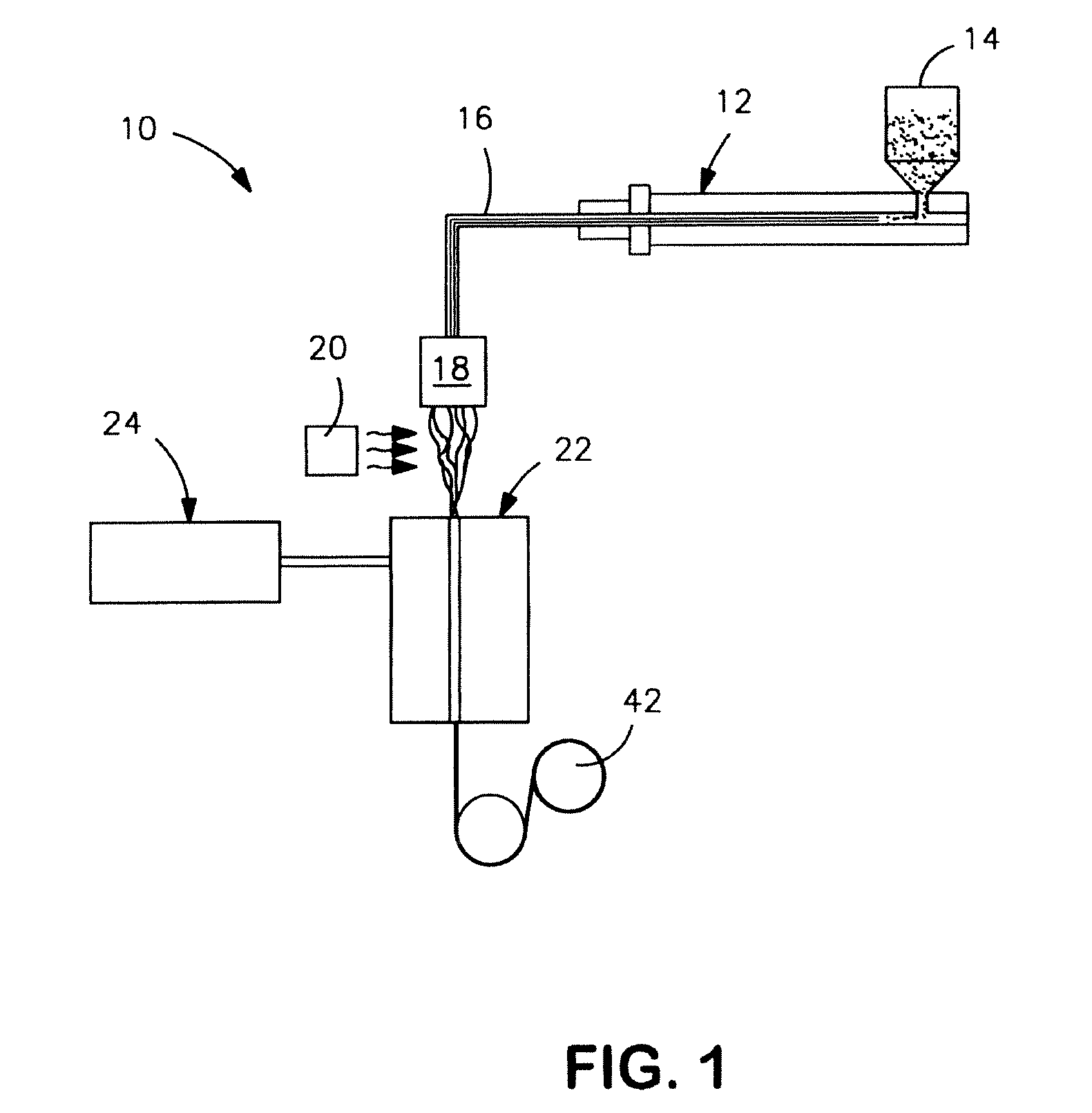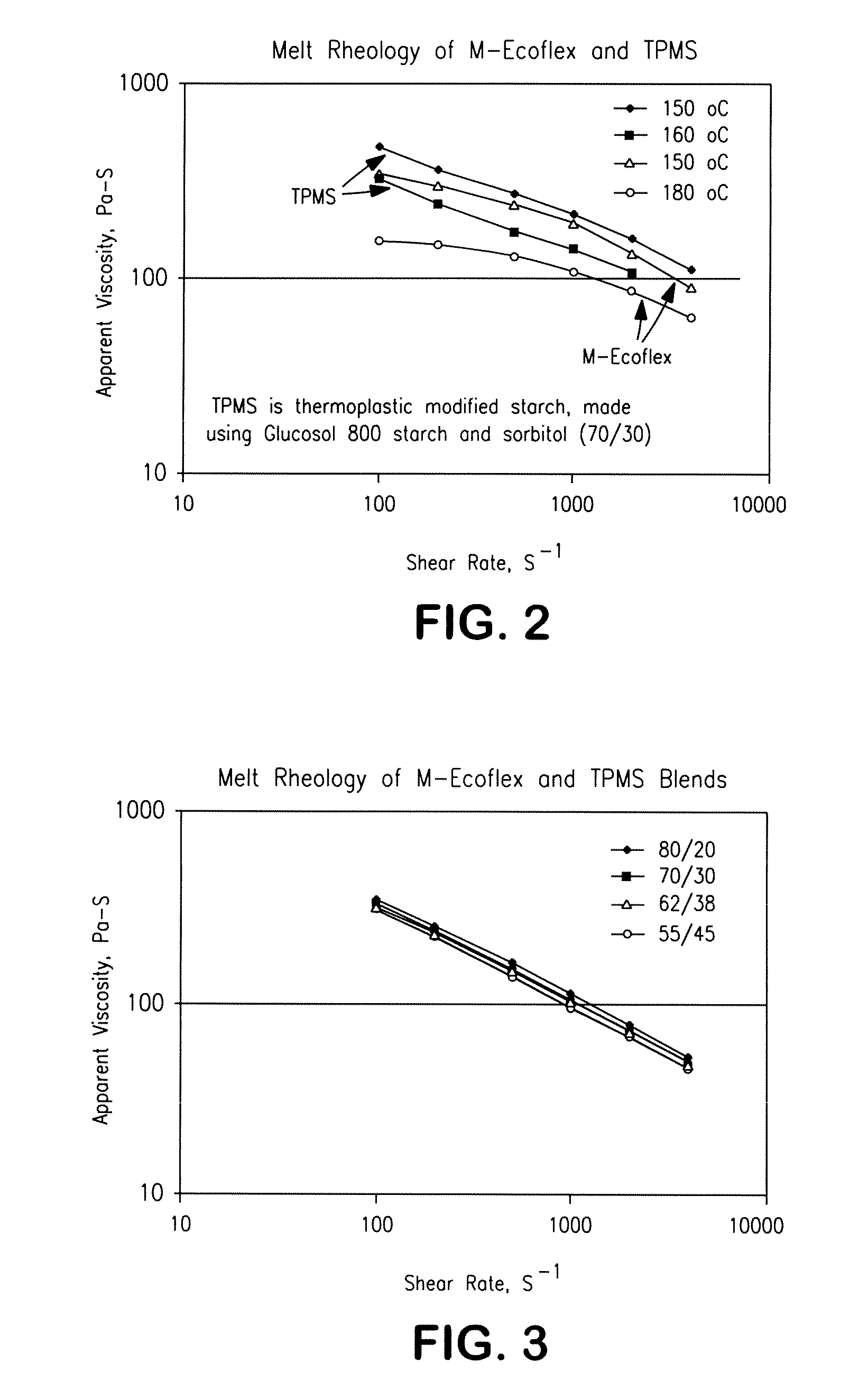Fibers Formed from a Blend of a Modified Aliphatic-Aromatic Copolyester and Thermoplastic Starch
a technology of thermoplastic starch and aliphatic aromatic, which is applied in the direction of weaving, manufacturing tools, melting spinning methods, etc., can solve the problems of inability to meet the requirements of industrial production, insufficient strength and mechanical properties of fibers, and inability to meet the requirements of many applications
- Summary
- Abstract
- Description
- Claims
- Application Information
AI Technical Summary
Problems solved by technology
Method used
Image
Examples
example 1
[0096]A thermoplastic hydroxypropylated starch was formed as follows. Initially, a mixture of a hydroxypropylated starch (Glucosol 800, manufactured by Chemstar Products Company, Minneapolis, Minn.), surfactant (Excel P-40S, Kao Corporation, Tokyo, Japan), and plasticizer (sorbitol) was made. Glucosol™ 800 has a weight average molecular weight (determined by gel permeation chromatography) of 2,900,000, a polydispersity index of about 28, a bulk density of about 30 to 40 lbs / ft3, and a D98 particle size of 140 Mesh. A Hobart mixer was used for mixing. The mixture was then added to a K-Tron feeder (K-Tron America, Pitman, N.J.) that fed the material into a co-rotating, twin-screw extruder (ZSK-30, diameter of 30 mm) that was manufactured by Werner and Pfleiderer Corporation of Ramsey, N.J. The extruder possessed 14 zones, numbered consecutively 1-14 from the feed hopper to the die. The first barrel #1 received the mixture at 19 lbs / hr when the extruder was heated to a temperature for ...
example 2
[0097]A modified biodegradable polyester was formed as follows. An aliphatic-aromatic copolyester resin was initially obtained from BASF under the designation ECOFLEX® F BX 7011. The copolyester resin was modified by melt blending with a reactant solution. The reactant solution contained 87.5 wt. % 1,4-butanediol, 7.5 wt. % ethanol, and 5 wt. % titanium propoxide. The solution was fed by an Eldex pump to a liquid injection port located at barrel #5 of a co-rotating, twin-screw extruder (ZSK-30). The polyester resin was fed to the twin screw extruder at barrel #1 using a gravimetric feeder at a throughput of 30 pounds per hour. The extruder had four (4) die openings having a diameter of 6 millimeters and separated by a distance of 3 millimeters. Upon formation, the extruded resin was cooled on a fan-cooled conveyor belt and formed into pellets by a Conair pelletizer. The concentration of reactants in the modified polyester was approximately 99.475 wt. % of the copolyester, 0.5 wt. % ...
examples 3-6
[0099]Blends of the thermoplastic starch of Example 1 and the modified copolyester of Example 2 were prepared using a ZSK-30 extruder according to the processing conditions set forth below in Table 2.
TABLE 2Processing Conditions for Compounding Fiber BlendsResinm-ExtruderFeeding RateTPSEcoflexSpeedExtruder Temperature Profile (° C.)PmeltTorqueSample No.(lb / hr)(lb / hr)(lb / hr)(rpm)T1T2T3T4T5T6T7Tmelt(psi)(%)Example 320416160100120140150150140130151140~17082~90Example 420614160100120140150150140130151140~18077~82Example 5207.612.4160100120140150150140130151 80~16068~73Example 620911160100120140150150140130151100~15065~71
[0100]The weight ratio of the modified copolyester (“m-Ecoflex”) to the thermoplastic starch (“TPS”) for Examples 3-6 was 80 / 20, 70 / 30, 62 / 38, and 55 / 45, respectively. Upon formation, the apparent viscosity of the blends was determined at 170° C. as described above. The results are shown in FIG. 3.
[0101]Thereafter, fiber spinning was conducted for the blends of Examples ...
PUM
| Property | Measurement | Unit |
|---|---|---|
| Temperature | aaaaa | aaaaa |
| Temperature | aaaaa | aaaaa |
| Temperature | aaaaa | aaaaa |
Abstract
Description
Claims
Application Information
 Login to View More
Login to View More - R&D
- Intellectual Property
- Life Sciences
- Materials
- Tech Scout
- Unparalleled Data Quality
- Higher Quality Content
- 60% Fewer Hallucinations
Browse by: Latest US Patents, China's latest patents, Technical Efficacy Thesaurus, Application Domain, Technology Topic, Popular Technical Reports.
© 2025 PatSnap. All rights reserved.Legal|Privacy policy|Modern Slavery Act Transparency Statement|Sitemap|About US| Contact US: help@patsnap.com



